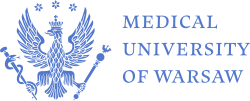Warszawski Uniwersytet Medyczny | |
 | |
| Latin: Universitas Medica Varsoviensis | |
Other name | WUM, MUW |
|---|---|
Former name | Medical Academy of Warsaw (1809–1816, 1950–2008) Medico-Chirurgical Academy (1857–1862) Doctoral Academy of Warsaw (Jan–Mar 1950) |
| Motto | Saluti Publicae |
Motto in English | Public Safety |
| Type | Public Research University |
| Established | 1809; 214 years ago |
| Founder | Wolff, Dziarkowski, Czekierski, Brandt, Celiński |
| Accreditation | Polish Accreditation Committee (PKA) |
Academic affiliation | EUA |
| Chancellor | Marta Kijak-Bloch |
| Rector | Zbigniew Gaciong |
Academic staff | 2,034 |
| Students | 9,764[1] (12.2023) |
| Postgraduates | 399 |
| 270 | |
| Address | 61 Żwirki i Wigury Street, 02-091 , , , Republic of Poland 52°12′21″N 20°59′08″E / 52.2059°N 20.9856°E |
| Campus | Urban |
| Language | Polish, English |
| Colors | |
| Nickname | AZS Uniwersytetu Medyczny Warszawskiego |
Sporting affiliations | University Sports Association of Poland |
| Website | Official website (in English) Official website (in Polish) |
 | |
The Medical University of Warsaw (Polish name: Warszawski Uniwersytet Medyczny) is one of the oldest and the largest medical schools in Poland. The first academic department of medicine was established as far back as two centuries ago in 1809. It is considered to be one of the most prestigious and reputable schools nationally for the medical sciences[citation needed], partly due to its affiliation with a number of large hospitals in Poland.
Originally known as the 'Medical Academy of Warsaw', its creation precedes that of the University of Warsaw, eventually merging as a single school, undergoing a considerable number of changes, before separating into the functionally autonomous university that is still operating today.
At the Medical University of Warsaw, general and specialty training are provided at both undergraduate and postgraduate levels. Students learn at five clinical teaching hospitals which provide general and tertiary medical care to patients. Students and staff also conduct scientific and clinical research at these hospitals in addition to involvement in a number of clinical academic departments located in other hospitals in the city.
WUM currently offers 16 degree programs including 3 full-time degree programs in English: Dentistry, Medicine, and Pharmacy. Among English-taught European schools, these are considered to be particularly well-established (the English Medical programme has been active since 1993).[2]
- ^ "Higher education in the 2023/24 academic year" (in Polish). Statistics Poland. Retrieved 2024-06-30.
- ^ "School Detail". search.wdoms.org. Retrieved 2023-08-30.